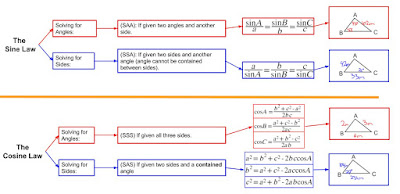Unit Test Review
~Trigonometry~
This blog post is a list of many of the key concepts that students should understand by the end of the trigonometry unit.
Chapter 7
- Rates, Ratios and Proportions
- Solving Proportions (Cross multiplication & isolation)
- Angle Relationships
- CAT, SAT, OAT, IST, SATT, EAT, PTL-F Pattern, PTL-C Pattern and PTL-Z Pattern
- The Pythagorean Theorem
- Two Properties of Similar Triangles
- Finding corresponding angles and corresponding sides in two similar triangles.
- Proportionality Statements
- Scale Factor (k)
- Primary Trigonometric Ratios
- Labeling hypotenuse, opposite side and adjacent side in respect to a reference angle
- The Tangent Ratio: solving for unknown angles and unknown sides
- The Cosine Ratio: solving for unknown angles and unknown sides
- Ratio cannot be greater than 1 (i.e., denominator is always greater than numerator).
- The Sine Ratio: solving for unknown angles and unknown sides
- Ratio cannot be greater than 1 (i.e., denominator is always greater than numerator).
- SOH CAH TOA
- Angle of Elevation (inclination)
- Angle of Depression
Chapter 8
- "Solving the Triangle"
- The Sine Law: solving for unknown angles and unknown sides
- The Cosine Law: solving for unknown angles and unknown sides
- The Sine Law vs. The Cosine Law
Chapter 7 & 8
- Solving Problems Using Trigonometry
- Formulas for Trigonometry



